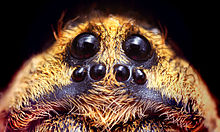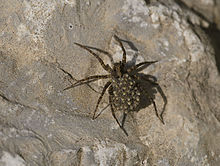Wolf spider
The wolf spiders (Lycosidae) form a family within the order of web spiders and belong to the superfamily Lycosoidea. The prominent spider family is one of the numerically largest of the order and is composed of small to very large species, the majority of which hunt without a net and instead live free-ranging as ambush hunters. Quite a few species, however, build shelters in the form of self-dug living tubes, which are provided with webs. Still other representatives live nomadically and use already existing hiding places, such as the underside of stones or wood as a temporary residence. The few species of wolf spiders that hunt with the help of a spider web use funnel webs for this purpose, such as those used by the species of the family of funnel spiders (Agelenidae).
The members of the almost worldwide distributed family of wolf spiders are long-legged and powerfully built. The enlarged posterior middle eyes, which are arranged directly in front, are conspicuous. The sense of sight is important for hunting and courtship, but not as well developed as in jumping spiders. Courtship in wolf spiders is composed of rhythmic and dance-like movements on the part of the males, for which the front extremities are used. Another peculiarity of wolf spiders is the distinct form of brood care. The egg cocoons are carried by the females after their completion attached to the spinnerets and the young climb after hatching on the opisthosoma (abdomen) of their mother and can be carried by this for some time before they separate from the mother and grow up independently.
The wolf spiders also include the "tarantulas" (formerly Tarentula; today mainly assigned to the genus Alopecosa), which, like all species of this family, are harmless to humans. Although larger specimens with their very powerful chelicerae (jaw claws) can also penetrate human skin, the quantity and concentration of the venom is not sufficient in any wolf spider to cause medically relevant consequences in humans.

Eye area of a Hogna species
Lifestyle
The larger wolf spiders (Arctosa, Trochosa, some Alopecosa), native to Central Europe, like most species of this family, inhabit burrows, which they line with spider silk from the inside, similar to the wallpaper spiders (Atypidae) or trapdoor spiders (Ctenizidae). Most other native species live in the herb layer or between stones, where they create living webs.
At night they leave their hiding place and go hunting: they wait in favourable places for an insect to pass by. From a few centimeters away, the wolf spider rushes forward and grabs the prey.
Members of the genus Pirata and Piratula prefer the proximity of standing water. On the smooth surface of the water they run without sinking and hunt insects on the water surface.

Top view of a wolf spider in the living tube
Reproduction
The male wolf spider approaches the mating-ready female with the front pair of legs raised. The male probably smells the readiness to mate from a distance of one meter. Courtship behavior is also triggered when threads of a female ready to mate are found. The male of Lycosa rabida vibrates its abdomen on the substrate, then makes circular movements in a fixed pattern with the pedipalps, which contain the seed pockets (bulb). This movement changes into an audible "palp drumming", which is produced with a stridulation organ.
During a pause, the mating female responds by tapping her front legs and takes a few steps towards the male, which then starts the courtship movement again. This continues until both almost touch each other; the first contact is reserved for the female. If the opposite is also a male by mistake, the courtship is immediately answered with a threatening stilt. In nocturnal species, acoustic signals play a greater role, in diurnal species the optical signals.
The male crawls onto the female from the front and first bends down on one side of the abdomen to insert the first palpus. The female aligns her abdomen accordingly. Then the second palpus is inserted from the other side.
In Rabidosa punctulata, a weak male has an evolutionary advantage in joining a copulating pair. They save energy and protect themselves from cannibalism by the female.
Brood care
Wolf spiders (Lycosidae) practice brood care. The egg cocoon is attached to the spinnerets (pardosa) by the wolf spiders during hunting or carried on the abdomen (water hunter, pirata) to be able to defend it from enemies. The egg cocoon is vigorously defended. If the cocoon is taken away from the female, objects similar to the cocoon, for example paper balls or small snail shells, are also carried around.
The female helps the young spiders to hatch by biting open the cocoon. The young immediately climb onto her back. While up to a hundred small wolf spiders cling to the mother's hair, often sit in several layers on top of each other and feed on her egg yolk, the mother roams around, presumably to find the best possible microclimatic conditions and good hiding places. In order not to expose herself to too much danger, she refrains from hunting during this phase, which lasts about eight days.
A female wolf spider can even be given a cocoon of a different species, which she will also take care of. The hatching young then climb onto the stepmother and let themselves be carried around.

Dark wolf spider with young

Wolf spider defending its egg cocoon

Dark wolf spider (Pardosa amentata) with egg cocoon
Questions and Answers
Q: What is the scientific name of Wolf spiders?
A: The scientific name of Wolf spiders is Lycosidae.
Q: How do Wolf spiders get their name?
A: Wolf spiders get their name from the way they hunt, which people thought was similar to how wolves hunt.
Q: What is the size range for Wolf spiders?
A: The smallest Wolf spider is less than 0.04 inches (1 mm) in body length and the largest are around 1.5 inches (38 mm) in body length.
Q: Do all wolf spiders live above ground?
A: No, not all wolf spiders live above ground; some dig burrows but come out to wander and hunt while others spend almost all of their lives waiting for passing insects in their burrows.
Q: What type of spider gives us the English name "tarantula"?
A: Hogna tarantula gives us the English name "tarantula".
Q: How does a female wolf spider lay her eggs?
A: A female wolf spider creates a clear space on the ground, lays down a rough sheet of silk, and then makes a silken cup on top of that sheet in which she lays her eggs. She then closes the cup making a round ball and holds onto it using her spinnerets until the babies begin to hatch.
Q: How do baby wolf spiders leave their mother's back?
A: After hatching from their mother's back, baby wolf spiders run up her legs and cover the top part of her body before leaving after being protected by their mother for a few days.
Search within the encyclopedia